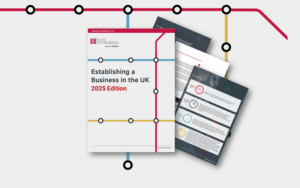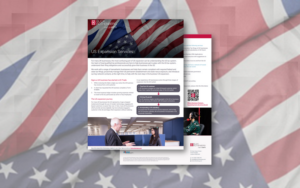An overview of the key tax considerations for an owner-managed business (OMB) during its life cycle, from start-up through to maturity and finally sale and succession
The Owner Managed Business Lifecycle: from Launch to Legacy

1: Start-up phase
The vast majority of mature OMBs will be structured in the form of a limited company/companies. The primary benefit of this structure is that it limits the owner’s liability, as the company trades as a separate legal personality. The Corporation Tax rate in the UK is also much lower than the highest rates of Income Tax, which means that profits can be reinvested back into the business much more efficiently within a company structure.
However, owners should carefully consider the merits of starting their business in a personal capacity (either as a sole trader or, where there is more than one owner, a partnership). This can be attractive for tax purposes as losses made in the early years can be offset against other income that the owner may have (e.g., from a concurrent employment), giving immediate Income Tax savings which can be used to finance the business further. Administrative costs are typically lower in these circumstances too. There is a specific tax framework in place which allows businesses to incorporate later when it makes sense to do so (which may be when the business is seeking external finance, for example).
![]()
![]()
2: Raising Finance
Tax policy in the UK has grown around the principle that new businesses can only thrive where they have good access to growth finance. For that reason, there are specific regimes in place which essentially incentivise investors to deploy funds into high-risk early-stage businesses. In short, those regimes provide investors with an immediate Income Tax saving, which is calculated as a percentage of their investment, the ability to defer existing realised capital gains, and a full Capital Gains Tax exemption on a future sale.
These regimes are highly targeted, and so only apply to businesses of a certain size and trading nature. However, where an OMB can secure qualification for those regimes, it becomes much easier to attract investment.
3: Business and employment taxes
As the business grows, so do its tax obligations. A key issue that is often missed by new businesses is their need to register for VAT, which usually comes quite early in the lifecycle as it’s a revenue-based assessment. This can be a costly mistake as late registration often results in a large immediate liability, which the business may not be in a position to meet.
A second key area of focus is staffing. Cash management often means that an OMB will start life with as much flexible labour as possible, which usually means contractor relationships where possible, which carry very little compliance burden for the OMB. However, at some point employees will be needed, and the OMB then needs to ensure that it is compliant with PAYE regulations, national minimum wage, and pensions auto-enrolment, and of course employment law.
Corporation Tax compliance tends to be relatively straightforward in the early loss-making years, but the OMB needs to ensure that it isn’t missing out on reliefs which could turn those losses into cash, for example under the Research and Development (R&D) framework.


4: Incentivising key employees
Attracting and retaining key talent can be challenging for a growing OMB, especially because cash constraints normally mean that employees can find higher salaries at more established competitors. For this reason, the provision of equity-based incentives to key individuals can be a powerful hiring, incentivisation and retention tool. The cost to the business of providing equity to employees is typically minimal, and equity plans can be built around the principle that if an employee leaves the business, they simply lose their equity stake. The equity ‘carrot’ therefore provides employees with the potential for huge upside but ensures that the business effectively suffers no cost if the employee does not stay the course.
There are highly tax efficient regimes for providing equity incentives to employees, as successive governments have recognised the value to the economy of employee ownership. The most prevalent is the Enterprise Management Incentive option arrangement, which provides a Capital Gains Tax return for employees (usually taxed at a rate of 10%), and a Corporation Tax saving for the business on the same amount.
5: Crossing borders
Compliance obligations for an OMB increase significantly once they start to have an international footprint, which means having suppliers, customers, or business activities outside of the UK (e.g., manufacturing goods abroad).
One area in which mistakes are common is accounting for VAT where the customer is abroad, especially where the product is in the form of a service. This can result in the need to register for VAT in the jurisdiction in which the customer is resident, and registration thresholds can be much lower than we have in the UK. It is also very common for VAT to be accounted for incorrectly in relation to invoices received from overseas suppliers.
Where goods are crossing borders, customs are a well-documented challenge, especially following Brexit. Cost and time considerations need to be factored into all cross-border customer and supplier relationships.
Lastly, where business activity is taking place abroad, the business may become liable to Corporation Tax in the jurisdiction in which that activity takes place, and where that threshold is breached it may make sense to incorporate a company locally to manage that taxable presence. The pricing of transactions between related companies in different jurisdictions needs to be considered carefully to ensure that there is a reasonable split of profits.


6: Preparing for an exit and legacy
For every owner there needs to ultimately be an exit from the business. More often than not, this takes the form of a sale, but in a minority of cases there is a family succession, with no liquidity event for the original owner.
Where a sale is being pursued, owners should ideally start planning for that event at least two years in advance. This period of preparation allows businesses to identify tax risks and eliminate or minimise them ahead of sale negotiations taking place, otherwise those risks may be reflected in price reductions.
The owner themselves should also use this period of time to ensure their ownership of the business is conducive to a tax efficient sale. For example, it is often the case that successful OMBs invest profits of the business into investment assets which need to be carved out before a tax efficient sale can take place. Owners should also think about wealth succession to future generations, as there is more scope for tax efficient planning ahead of a sale event than after it has taken place. Trust and company structures can both facilitate a transfer of economic ownership while allowing the original owner to retain control, which can be particularly useful where the next generation are still in their formative years.
Would you like to know more?
If you would like to discuss any of the above, including where your owner managed business is in its lifecycle, please contact get in touch with your usual Blick Rothenberg contact or Genevieve and Rob via thier profile pages or using the form below.
Contact us













